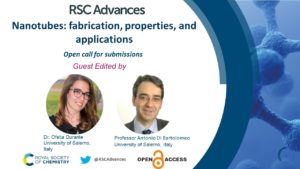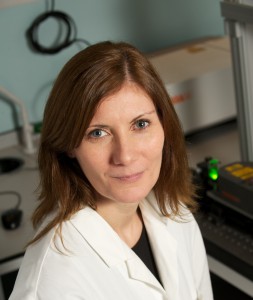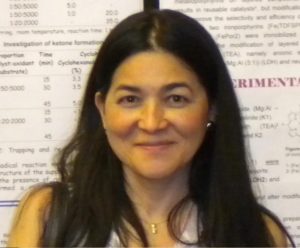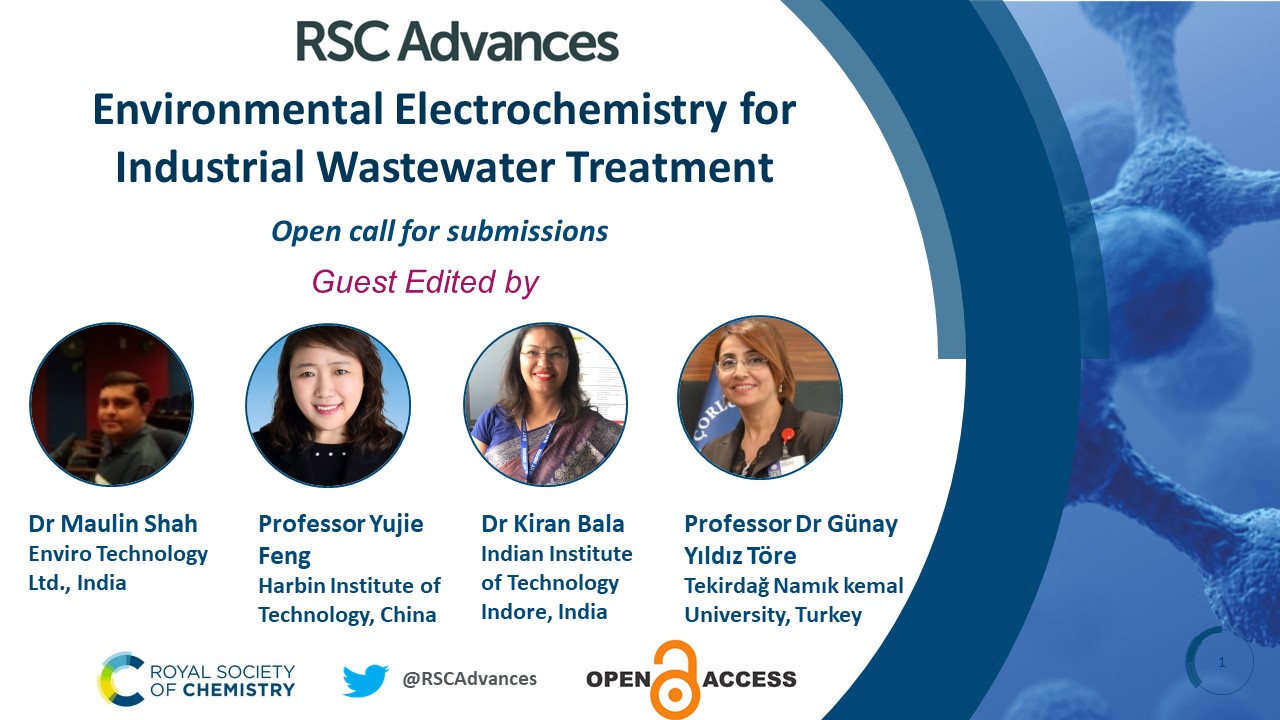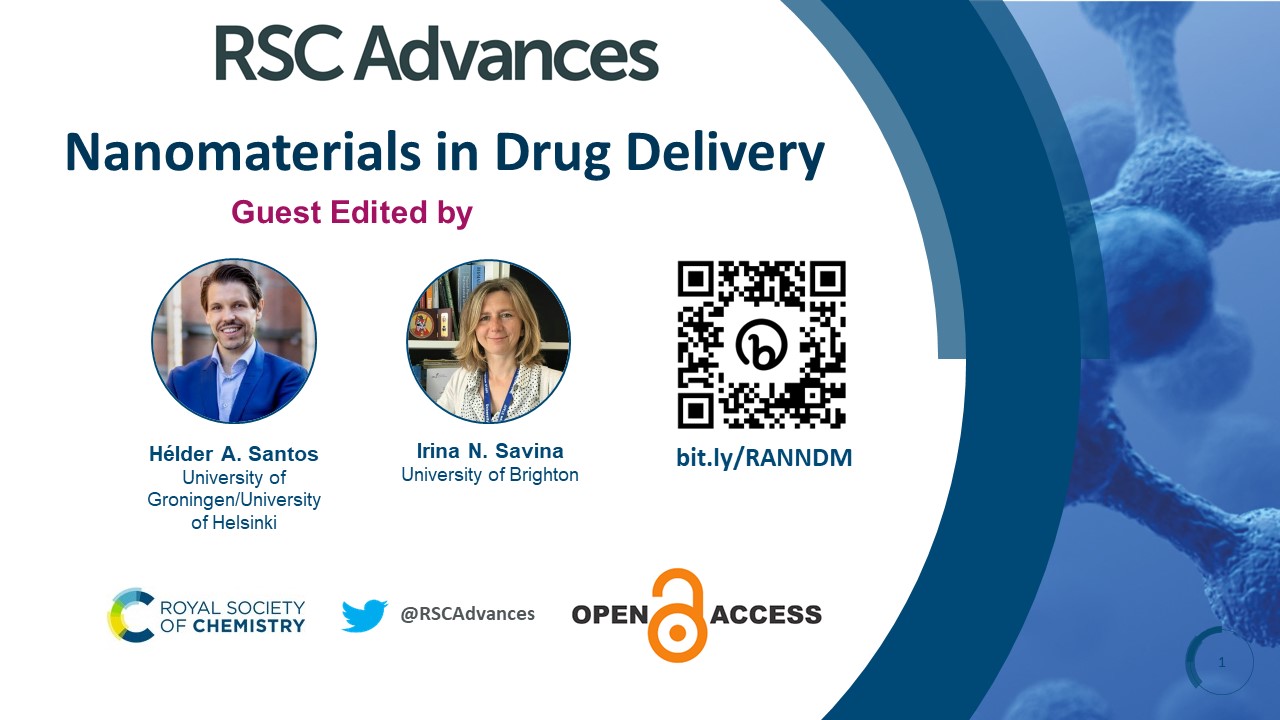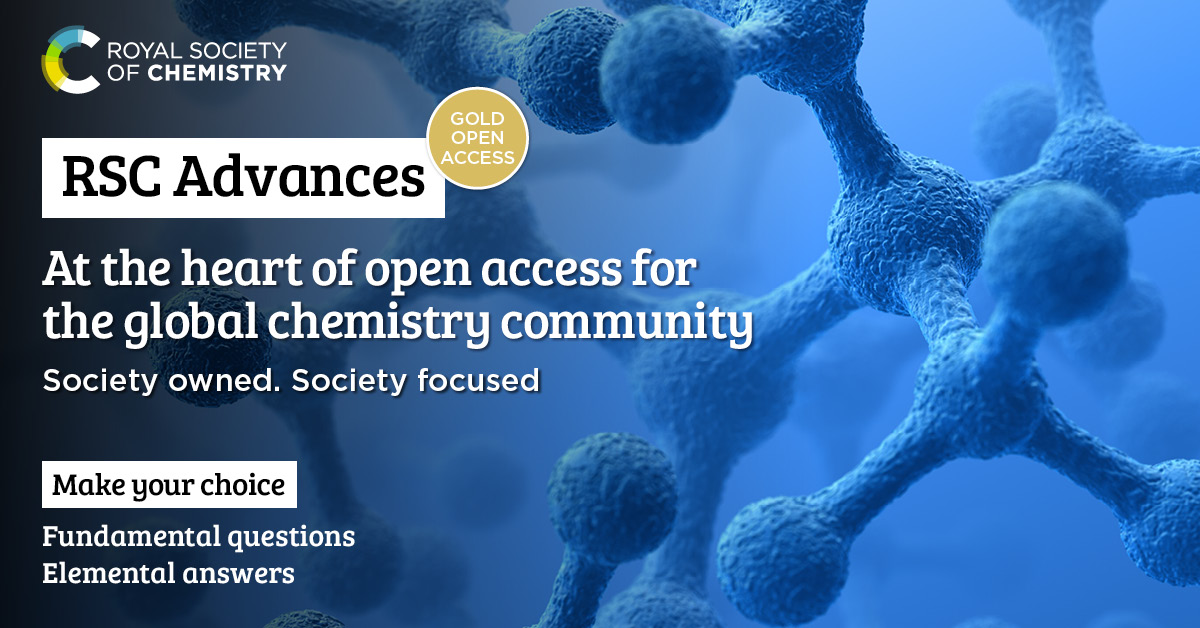International Women’s Day (IWD) is celebrated annually on March 8th to honour the achievements of women all around the world. IWD has been observed since 1911 and remains significant in driving positive change for women. In honour of this day, at RSC Advances, would like to take the opportunity to highlight some members of our Editorial Board and Associate Editor group. These members share some of their own perspectives of being a woman in science, technology, engineering and maths (STEM), and provide some guidance for researchers.
Prof Shannon Biros, Associate Editor, Grand Valley State University, USA

What advice would you give to early career female researchers?
I would tell early career female researchers to never give up. Building a career in science is hard; I think it is hard for everyone, just in different ways. I would tell them that they are going to make plenty of mistakes, and when they do to learn from them and move forward. I would tell them to always stand up for themselves, and to trust their instincts. I would tell them that they are smart enough, they do work hard enough, and they do belong here. And then I would tell them that balance is important, to make sure they have friends and interests outside of their career. Lastly, I would tell them that they should have a job that they look forward to going to every day (well…most days) that brings them joy. If their current job doesn’t do that, then it’s time to reassess. But to always remember that they can do this, and that just because it’s hard doesn’t mean it’s not right.
Shannon’s top publications:
Synthesis of diphenyl-(2-thienyl)phosphine, its chalcogenide derivatives and a series of novel complexes of lanthanide nitrates and triflates
Troy Luster, Hannah J. Van de Roovaart, Kyle J. Korman, Georgia G. Sands, Kylie M. Dunn, Anthony Spyker, Richard J. Staples, Shannon M. Biros and John E. Bender
Dalton Trans., 2022,51, 9103-9115
Supramolecular ligands for the extraction of lanthanide and actinide ions
Eric J. Werner and Shannon M. Biros
Org. Chem. Front., 2019,6, 2067-2094
X-ray crystallographic, luminescence and NMR studies of phenacyldiphenylphosphine oxide with the Ln(iii) ions Sm, Eu, Gd, Tb and Dy
Erin G. Leach, Justin R. Shady, Adam C. Boyden, Anne-lise Emig, Alyssa T. Henry, Emily K. Connor, Richard J. Staples, Stephanie Schaertel, Eric J. Werner and Shannon M. Biros
Dalton Trans., 2017,46, 15458-15469
Dr Vandana Bhalla, Associate Editor, Guru Nanak Dev University, India

What are some of the challenges you have faced as a woman in science and what positive progress have you seen throughout your career so far?
In the field, I have definitely faced my share of challenges. Starting from the basic level of scoring a job interview and unfavourable work environment due to subconscious and unintended gender insensitivity. To receive similar levels of recognition/respect for my research work as received by male colleagues, I had to show exceptional productivity.
Fortunately, I am lucky enough to witness the positive progress in the field. We are now initiating the conversation about this issue at all levels. Multiple initiatives have already been started to achieve gender equity in STEM like increased job openings, funding opportunities for women.
What do you think are the main factors perpetuating the gender gap in STEM fields, and what can we do to help close this gap?
In my opinion, there are multiple prejudices that contribute towards the large gender gap in STEM. It is common practice to refer a male researcher as ‘Scientist ‘ while the female counterpart is referred as ‘Female Scientist’. The general perception about STEM as a career is that it requires high intelligent quotient (IQ) and low emotional quotient (EQ) and consequently, people with high EQs are usually considered unsuitable for the field.
To close the gap, efforts are needed at multiple educational levels starting from the primary schools. It is important to educate young minds that there is no competition to prove gender superiority rather we are working as a team to build sustainable future through positive initiatives in STEM.
Why do you think it is that women are often under-represented at senior levels? What are the benefits of taking on a leadership role?
According to me there is an uneven competition in the pathway to reach up the ladder.
Taking up leadership roles is essential in shaping the careers of young researchers. It is important to have an opportunity to bring your opinion to the table. Often women participation at senior levels is to complete the checklist, it is imperative to turn it into true representation.
The theme of this year’s IWD is Embrace Equity. Do you have any recommendations for improving the STEM workforce to create an environment that better supports women?
Honestly, I believe that holistic approach is required to improve effective participation of women in STEM. Interventions should be made at multiple levels starting from promoting gender equity at home, gender sensitivity at educational institutions and gender inclusivity at work place. More job openings and research opportunities should be created to close the gap.
Vandana’s top publications:
Enzyme-/metal-free quinoxaline assemblies: direct light-up detection of cholesterol in human serum
Amrit Kaur, Manoj Kumar and Vandana Bhalla
Chem. Commun., 2023,59, 1501-1504
A photocatalytic ensemble HP-T@Au-Fe3O4: synergistic and balanced operation in Kumada and Heck coupling reactions
Harpreet Kaur, Manoj Kumar and Vandana Bhalla
Green Chem., 2020,22, 8036-8045
Visible light promoted PANI@Au:CuO catalyzed sequential amination, azidation and annulation for the preparation of 2-arylbenzimidazoles
Radhika Chopra, Manoj Kumar, Neelam and Vandana Bhalla
Green Chem., 2019,21, 3666-3674
Dr Estelle Roth, Associate Editor, University of Reims, France
 What do you think are the main factors perpetuating the gender gap in STEM fields, and what can we do to help close this gap?
What do you think are the main factors perpetuating the gender gap in STEM fields, and what can we do to help close this gap?
In my opinion, the main obstacle lies in the self-censorship of women in the consideration of a scientific career due to lack of confidence and a position behind the male sex. Many actions are currently being conducted to remedy this situation; for example, in France, the association Femmes et Sciences, of which I am a member, promotes scientific studies among young girls and supports doctoral students at the end of their thesis and in the construction of their careers. As well, recruitment of assistant professors to limit gender bias…. and so on.
What advice would you give to early career female researchers?
Recruitment of lecturers is accompanied by training to limit gender bias. So my main advice would be to be self-confident and ambitious, and don’t worry about pregnancy affecting your career.
Why do you think it is that women are often under-represented at senior levels? What are the benefits of taking on a leadership role?
Women are still underrepresented in high responsibility jobs. I don’t think they are hindered in taking on responsibility, but they are not recognized in an official capacity. For example, being a woman should not affect whether you are the project investigator of a scientific project. Gender balance is a requirement for institutions. However, it is still much more difficult for women to reach the status of Professor or Director of a scientific institute. Women face the “glass ceiling” as we say in French!
Estelle’s top publications:
Gas-phase UV absorption spectra and OH-oxidation kinetics of 1H-1,2,3-triazole and pyrazole
Brahim Samir, Carmen Kalalian, Estelle Roth, Rachid Salghi and Abdelkhaleq Chakir
RSC Adv., 2019,9, 27361-27368
Prof Shivani Bhardwaj Mishra, Associate Editor, University of South Africa, Johannesburg
 What are some of the challenges you have faced as a woman in science and what positive progress have you seen throughout your career so far?
What are some of the challenges you have faced as a woman in science and what positive progress have you seen throughout your career so far?
Being a woman, the challenges started appearing at the very start of my academic journey as a student transitioning to a career in STEM. I could not score any fellowships for any of my degrees, and therefore made myself self-sufficient in pursing higher studies by outsourcing my knowledge as a tutor. The challenge was juggling university and work to contribute towards my academic expenses. At the time, it was tiring and demotivating but it helped me to develop teaching skills as well as retain the fundamentals of my chosen discipline and its implementation to research and development. A challenge can be difficult but if it is taken advantage of it can transform career. The opportunity in higher education lacked resources but even this challenge was a blessing in disguise that made me understand the value of collaboration, which also helped me to develop global networking at a later stage of my career.
What do you think are the main factors perpetuating the gender gap in STEM fields, and what can we do to help close this gap
Unfortunately, its a huge gap. There are many factors for this, including underestimating the capabilities of women understanding STEM, and the patriarchal power play that involves demoralising ambitious women. To add onto is social stigma, there are set norms for woman regarding families, society and academic fraternity. STEM is gender biased just like any other sector. There is a need to bridge the gap in order to provide a platform for the flowers to bloom to their and contribute or participate towards further scientific advancement. For this, the academic sector has to work together with Government and other academic bodies at their respective levels to promote gender equity in STEM by introducing more fellowships, positions, academic women’s organizations and universities dedicated to uplift the STEM gap.
What advice would you give to early career female researchers?
The best advise to early career female researchers is “Never give up girls” if STEM is your dream. Transform your challenge into a long term investment for your career. Identify the purpose of your dreams and your life and respect your existence. No challenge is bigger or difficult than your will power. Stay patient when time tests you or your passion and keep working hard and the right opportunity will knock on your door at the right time.
The theme of this year’s IWD is Embrace Equity. Do you have any recommendations for improving the STEM workforce to create an environment that better supports women?
I would recommend new opportunities dedicated to women, new STEM institutions supporting only women both at leadership positions and as a work force. Promoting their achievements and contributing towards career development. Celebrating their performances locally and globally to present role models to new generation of STEM. Bring forward the historical STEM women who made significant contributions by organizing funds, holding conferences, colloquium, and symposiums in the name of these STEM women. Special issues dedicated to woman scientists could provide assistance, as well as support, through fellowships.
Shivani’s top publications:
Mechanistic pathways for the degradation of SMX drug and floatation of degraded products using F–Pt co-doped TiO2 photocatalysts
Majid Jahdi, Shivani B. Mishra, Edward N. Nxumalo, Sabelo D. Mhlanga and Ajay K. Mishra
RSC Adv., 2020,10, 27662-27675
Dr Xi Chen, Associate Editor, Shanghai Jiao Tong University, China
 What are some of the challenges you have faced as a woman in science and what positive progress have you seen throughout your career so far? Why do you think it is that women are often under-represented at senior levels? What are the benefits of taking on a leadership role?
What are some of the challenges you have faced as a woman in science and what positive progress have you seen throughout your career so far? Why do you think it is that women are often under-represented at senior levels? What are the benefits of taking on a leadership role?
As a female researcher, I am delighted to be invited by RSC Advances to share my experience. When I was looking for a faculty position, women were still underrepresented in many fields of science, particularly in leadership positions. But today, more women are entering the field of science and pursuing advanced degrees in STEM fields. And more women are being appointed to leadership positions in science. For example, two women—Prof Lesley Yellowlees and Dame Carol Vivien Robinson—have held the presidency of RSC in the past ten years. These women can help us better advocate for gender equality in STEM fields. These are all gratifying progress. Also, as a mother, I sometimes struggle to balance my work and personal life. Fortunately, I have family members and colleagues who always support me on the road of scientific research, take care of me and share happiness with me.
What advice would you give to early career female researchers?
Some women with great scientific research potential may give up their favourite career due to the pressure of some traditional ideas or the need to take on more family tasks, but I want to encourage those outstanding female researchers not to give up easily, but to follow their hearts, be the truest self and don’t set limits on life. There may be a lot of challenges for early female researchers, but I hope we can have more courage and determination to go the way we like.
Xi’s top publications:
Acid hydrolysis of chitin in calcium chloride solutions
Yudi Wang, Jia Kou, Xuewei Wanga and Xi Chen
Green Chem., 2023, Advance Article
Base-catalysed, one-step mechanochemical conversion of chitin and shrimp shells into low molecular weight chitosan
Xi Chen, Huiying Yang, Ziyi Zhong and Ning Yan
Green Chem., 2017,19, 2783-2792
Direct conversion of chitin into a N-containing furan derivative
Xi Chen, Shu Ling Chew, Francesca M. Kerton and Ning Yan
Green Chem., 2014,16, 2204-2212
Prof Abha Misra, Associate Editor, IISc Bangalore, India
 What are some of the challenges you have faced as a woman in science and what positive progress have you seen throughout your career so far?
What are some of the challenges you have faced as a woman in science and what positive progress have you seen throughout your career so far?
It is difficult to find support from women and mentors to give advice on how to tackle the challenges that you face to make any significant progress in your early career. A slow and steady progress pays off in a long run.
What advice would you give to early career female researchers?
My advice is to see challenges as opportunities which bring a completely different perspective and can help with positive progress. It is important to be role model for other women facing similar problems and be part of the system to make changes for the young women of the future.
The theme of this year’s IWD is Embrace Equity. Do you have any recommendations for improving the STEM workforce to create an environment that better supports women?
Provide a support system to ensure an environment of trust and enable an understanding of the challenges faced. Women should also be given support at senior levels especially when it becomes important to have more role models.
Abha’s top publications:
Self-powered ZnO-based pyro-phototronic photodetectors: impact of heterointerfaces and parametric studies
Vinod Panwar, Sukanta Nandi, Mandira Majumder and Abha Misra
J. Mater. Chem. C, 2022,10, 12487-12510
Role of the electrode-edge in optically sensitive three-dimensional carbon foam-MoS2 based high-performance micro-supercapacitors
Sumana Kumar, Anwesha Mukherjee, Swanand Telpande, Ayon Das Mahapatra, Praveen Kumar and Abha Misra
J. Mater. Chem. A, 2023,11, 4963-4976
Stacked vanadium pentoxide–zinc oxide interface for optically-chargeable supercapacitors
Pankaj Singh Chauhan, Sumana Kumar, Anindita Mondal, Pragya Sharma, Mihir N. Parekh, Vinod Panwar, Apparao M. Rao and Abha Misra
J. Mater. Chem. A, 2023,11, 95-107
Dr Donna Arnold, Associate Editor, University of Kent, UK
 What are some of the challenges you have faced as a woman in science and what positive progress have you seen throughout your career so far?
What are some of the challenges you have faced as a woman in science and what positive progress have you seen throughout your career so far?
Early in my career I found that I would be the only woman in a meeting. Sometimes this even meant that no one would know where female toilets were located! This could make you feel like you did not belong. Things have changed. There is now normally much wider representation in meetings and on the occasions where this is not the case there is enough awareness to ensure that it is a meeting of scientific equality.
What advice would you give to early career female researchers?
Change will only come from within. Do not be put off if you find yourselves in challenging environments and do not feel guilty for striving to have a career and a family. Both are possible. Remember that you are the voices of change and that once you get to the later part of your own career you are the voice that will inspire next generations and facilitate further change.
Why do you think it is that women are often under-represented at senior levels? What are the benefits of taking on a leadership role?
Whilst things are definitely changing women are more likely to take career breaks and then juggle family life alongside a STEM career. The demands of senior management often pulls against this. Additionally, these roles often require a certain seniority and thus also come about when women are entering menopause. This comes with self-doubt and other complicated emotional, mental health and physical states. We are still not open enough about menopause and the effects it can have on women and how that fits with delivering work demands.
Taking a leadership role can help to affect change and provide platform from which to do so. These are also the roles that end up shaping roles for early career individuals so it is important to have broad representation.
Donna’s top publications:
A new series of sodium cobalt oxyhydrates
Sundip Mistry, Donna C. Arnold, Chris J. Nuttall, Alexandros Lappas and Mark A. Green
Chem. Commun., 2004, 2440-2441
B-cation effects in relaxor and ferroelectric tetragonal tungsten bronzes
Donna C. Arnold and Finlay D. Morrison
J. Mater. Chem., 2009,19, 6485-6488
Investigation of the role of morphology on the magnetic properties of Ca2Mn3O8 materials
Laura J. Vera Stimpson, Silvia Ramos, Gavin B. G. Stenning, Marek Jura, Stephen Parry, Giannantonio Cibin and Donna C. Arnold
Dalton Trans., 2017,46, 14130-14138
Dr Parukuttyamma Sujatha Devi, Associate Editor, CSIR-National Institute for Interdisciplinary Science and Technology, India
 What are some of the challenges you have faced as a woman in science and what positive progress have you seen throughout your career so far?
What are some of the challenges you have faced as a woman in science and what positive progress have you seen throughout your career so far?
Meeting both domestic responsibilities and professional activities has been a major challenge throughout my career. I have always motivated myself to do so.
What advice would you give to early career female researchers?
Equal opportunities have rarely been given to female researchers. So my advice to early career researchers would be to motivate yourself and stay inspired, even by smaller successes and recognitions in your career. Don’t be defeated – follow your consciousness and success will follow.
The theme of this year’s IWD is Embrace Equity. Do you have any recommendations for improving the STEM workforce to create an environment that better supports women?
Flexibility in the work place! The lack of adequate numbers of female mentors is a lacuna in STEM.
Devi’s top publications:
Some interesting insights into the acetone sensing characteristics of monoclinic WO3
Puja Ghosh, M Manikandan, Shrabanee Sen, Parukuttyamma Sujatha Devi,
Mater. Adv., 2023,4, 1146-1160
ZnO decorated ZnSnO3 as efficient fillers to PVDF: toward simultaneous enhancement of energy storage density and efficiency and improved energy harvesting activity
Abhishek Sasmal, Samar Kumar Medda, Parukuttyamma Sujatha Devi, Shrabanee Sen Nano
Nanoscale, 2020,12, 20908-20921
Surface functionalized multifunctional ZnFe2O4 nanoparticles as ad carrier of hydrophobic and hydrophilic anti-cancer drug molecules
Debabrata Maiti, Arindam Saha and Parukuttyamma Sujatha Devi
Phys. Chem. Chem. Phys., 2016,18, 1439-1450

Check out our Women in Chemistry page to learn more about women working as chemists and the issues that affect them in science education.
In 2019, the Royal Society of Chemistry published a report to assess if publishing in the chemical sciences is gender biased. The full report and guidance as a result of the findings can be viewed here https://www.rsc.org/new-perspectives/talent/gender-bias-in-publishing
Comments Off on International Women’s Day – Associate Editors
 Submit to RSC Advances today! Check out our author guidelines for information on our article types or find out more about the advantages of publishing in a Royal Society of Chemistry journal.
Submit to RSC Advances today! Check out our author guidelines for information on our article types or find out more about the advantages of publishing in a Royal Society of Chemistry journal.

